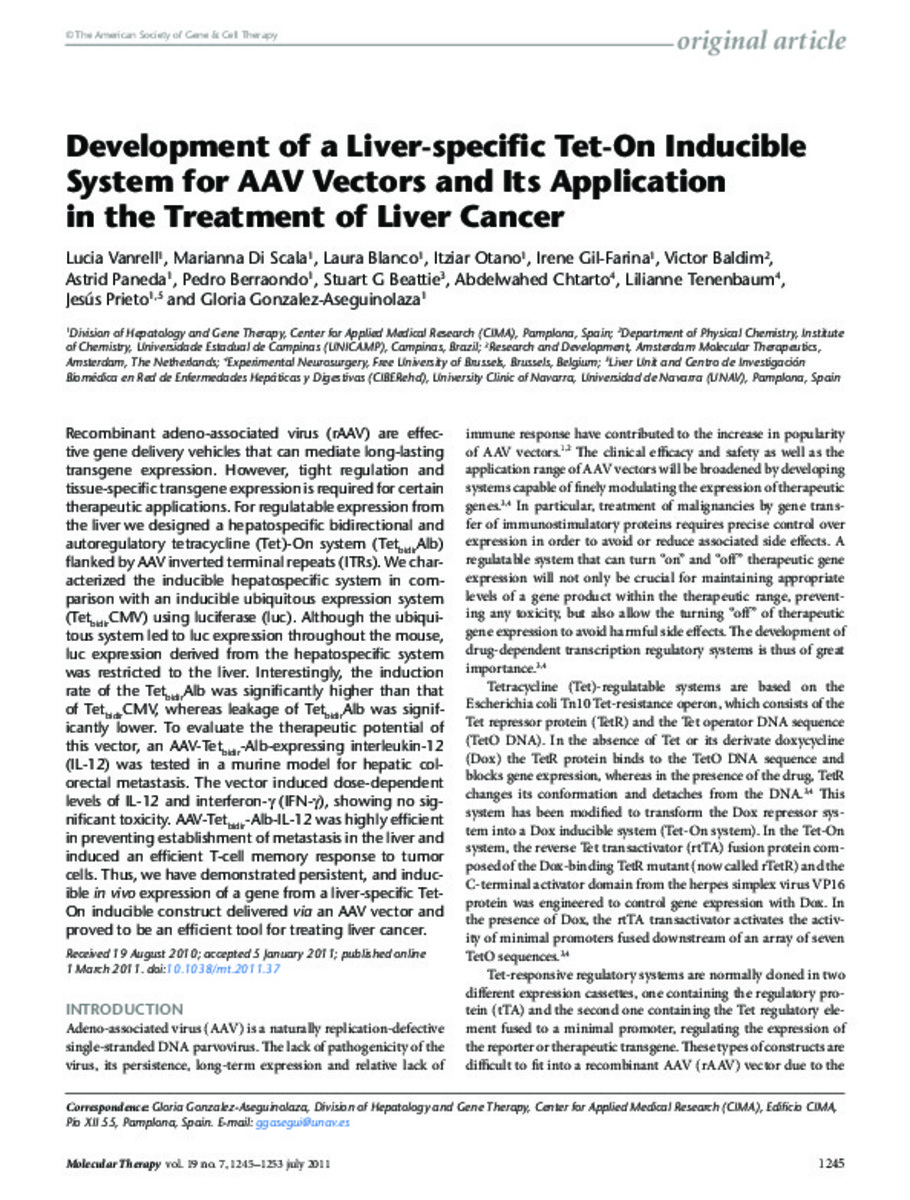Full metadata record
| DC Field | Value | Language |
|---|---|---|
| dc.creator | Vanrell, L. (Lucía) | - |
| dc.creator | Scala, M. (Marianna) Di | - |
| dc.creator | Blanco-Fernández, L. (Laura) | - |
| dc.creator | Otano, I. (Itziar) | - |
| dc.creator | Gil-Fariña, I. (Irene) | - |
| dc.creator | Baldim, V. (Victor) | - |
| dc.creator | Pañeda, A. (Astrid) | - |
| dc.creator | Berraondo, P. (Pedro) | - |
| dc.creator | Beattie, S.G. (Stuart G.) | - |
| dc.creator | Chtarto, A. (Abdelwahed) | - |
| dc.creator | Tenenbaum, L. (Lilianne) | - |
| dc.creator | Prieto, J. (Jesús) | - |
| dc.creator | González-Aseguinolaza, G. (Gloria) | - |
| dc.date.accessioned | 2014-07-15T07:38:35Z | - |
| dc.date.available | 2014-07-15T07:38:35Z | - |
| dc.date.issued | 2011 | - |
| dc.identifier.citation | Vanrell L, Di Scala M, Blanco L, Otano I, Gil-Farina I, Baldim V, et al. Development of a liver-specific Tet-on inducible system for AAV vectors and its application in the treatment of liver cancer. Mol Ther. 2011 Jul;19(7):1245-53. | es_ES |
| dc.identifier.issn | 1525-0016 | - |
| dc.identifier.uri | https://hdl.handle.net/10171/36151 | - |
| dc.description.abstract | Recombinant adeno-associated virus (rAAV) are effective gene delivery vehicles that can mediate long-lasting transgene expression. However, tight regulation and tissue-specific transgene expression is required for certain therapeutic applications. For regulatable expression from the liver we designed a hepatospecific bidirectional and autoregulatory tetracycline (Tet)-On system (Tet(bidir)Alb) flanked by AAV inverted terminal repeats (ITRs). We characterized the inducible hepatospecific system in comparison with an inducible ubiquitous expression system (Tet(bidir)CMV) using luciferase (luc). Although the ubiquitous system led to luc expression throughout the mouse, luc expression derived from the hepatospecific system was restricted to the liver. Interestingly, the induction rate of the Tet(bidir)Alb was significantly higher than that of Tet(bidir)CMV, whereas leakage of Tet(bidir)Alb was significantly lower. To evaluate the therapeutic potential of this vector, an AAV-Tet(bidir)-Alb-expressing interleukin-12 (IL-12) was tested in a murine model for hepatic colorectal metastasis. The vector induced dose-dependent levels of IL-12 and interferon-γ (IFN-γ), showing no significant toxicity. AAV-Tet(bidir)-Alb-IL-12 was highly efficient in preventing establishment of metastasis in the liver and induced an efficient T-cell memory response to tumor cells. Thus, we have demonstrated persistent, and inducible in vivo expression of a gene from a liver-specific Tet-On inducible construct delivered via an AAV vector and proved to be an efficient tool for treating liver cancer. | es_ES |
| dc.language.iso | eng | es_ES |
| dc.publisher | Nature | es_ES |
| dc.relation | info:eu-repo/grantAgreement/SNSF/Project funding/31003A_127177/CH | - |
| dc.rights | info:eu-repo/semantics/openAccess | es_ES |
| dc.subject | Gene Expression Regulation, Neoplastic/drug effects | es_ES |
| dc.subject | Genetic Therapy/methods | es_ES |
| dc.subject | Liver Neoplasms/genetics | es_ES |
| dc.subject | Alanine Transaminase/blood | es_ES |
| dc.subject | Aspartate Aminotransferases | es_ES |
| dc.subject | HeLa Cells | es_ES |
| dc.title | Development of a liver-specific Tet-on inducible system for AAV vectors and its application in the treatment of liver cancer | es_ES |
| dc.type | info:eu-repo/semantics/article | es_ES |
| dc.identifier.doi | http://dx.doi.org/10.1038/mt.2011.37 | es_ES |
Files in This Item:
Statistics and impact
Items in Dadun are protected by copyright, with all rights reserved, unless otherwise indicated.






